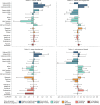Regional and institutional trends in assessment for academic promotion
- PMID: 39843736
- PMCID: PMC11821531
- DOI: 10.1038/s41586-024-08422-9
Regional and institutional trends in assessment for academic promotion
Abstract
The assessment of research performance is widely seen as a vital tool in upholding the highest standards of quality, with selection and competition believed to drive progress. Academic institutions need to take critical decisions on hiring and promotion, while facing external pressure by also being subject to research assessment1-4. Here we present an outlook on research assessment for career progression with specific focus on promotion to full professorship, based on 314 policies from 190 academic institutions and 218 policies from 58 government agencies, covering 32 countries in the Global North and 89 countries in the Global South. We investigated how frequently various promotion criteria are mentioned and carried out a statistical analysis to infer commonalities and differences across policies. Although quantitative methods of assessment remain popular, in agreement with what is found in more geographically restricted studies5-9, they are not omnipresent. We find differences between the Global North and the Global South as well as between institutional and national policies, but less so between disciplines. A preference for bibliometric indicators is more marked in upper-middle-income countries. Although we see some variation, many promotion policies are based on the assumption of specific career paths that become normative rather than embracing diversity. In turn, this restricts opportunities for researchers. These results challenge current practice and have strategic implications for researchers, research managers and national governments.
© 2025. The Author(s).
Conflict of interest statement
Competing interests: The authors declare no competing interests.
Figures









References
-
- Wilsdon, J. et al. The Metric Tide: Report of the Independent Review of the Role of Metrics in Research Assessment and Management (HEFCE, 2015); 10.13140/RG.2.1.4929.1363.
-
- Curry, S., Gadd, E. & Wilsdon, J. Harnessing the Metric Tide: Indicators, Infrastructures & Priorities for UK Responsible Research Assessment – Report of The Metric Tide Revisited Panel (RORI, 2022); 10.6084/m9.figshare.21701624.
-
- Fauzi, M. A., Tan, C. N. L., Daud, M. & Awalludin, M. M. N. University rankings: a review of methodological flaws. Issues Educ. Res.30, 79–96 (2020).
-
- Parker, J. Comparing research and teaching in university promotion criteria. High. Educ. Q.62, 237–251 (2008).
LinkOut - more resources
Full Text Sources

